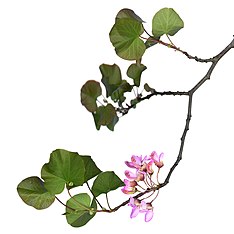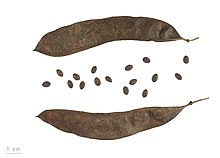Cercis siliquastrum
| Cercis siliquastrum | |
|---|---|

| |
| Scientific classification | |
| Kingdom: | Plantae |
| Clade: | Tracheophytes |
| Clade: | Angiosperms |
| Clade: | Eudicots |
| Clade: | Rosids |
| Order: | Fabales |
| Family: | Fabaceae |
| Genus: | Cercis |
| Species: | C. siliquastrum
|
| Binomial name | |
| Cercis siliquastrum | |
| Synonyms | |
| |
Cercis siliquastrum, commonly known as the Judas tree or Judas-tree,[1] is a small deciduous species of redbud in the flowering plant family Fabaceae which is noted for its prolific display of deep pink flowers in spring. It is native to Southern Europe and Western Asia.
Description
[edit]


This species forms a small tree up to 12 m (39 ft) in height and 10 m (32 ft) in width.[2]
The deep pink flowers are produced on year-old or older growth, including the trunk, in spring. They have five free petals and fused sepals, a flower shape typical of much of the pea family (Fabaceae). The leaves appear shortly after the first flowers emerge. These are cordate with a blunt apex and occasionally have a shallow notch at the tip. The tree produces long flat pods that hang vertically. The flowers are edible and reportedly have a sweet and tart taste.[2]
Taxonomy
[edit]
The species was first described by Linnaeus in 1753 and he gave it the specific epithet of siliquastrum which is derived from the Latin word siliqua, meaning "pod".[3] The generic name comes from the Greek kerkis, a "shuttle", which refers to the resemblance shown to this weaver's tool by the flat, woody seedpods.[4]
There are several varieties and subspecies including:-
- var. hebecarpa Bornm.
- nothosubsp. yaltikirii (Ponert) Govaerts
- var. siliquastrum
- var. alba Weston
Distribution and ecological aspects
[edit]




The flowers are pollinated by bees, which are attracted by nectar. Pollen from the protruding stamens is deposited on the bee's body and carried to another flower's stigma.[5]
In Israel the tree has a status of a protected plant.
British journalist Francis McCullagh reported seeing "innumerable" flowering specimens of this tree in Yildiz Park in Istanbul in April 1909.[6]
Cultivation
[edit]The species prefers deep, well-drained soils and a position in full sun or partial shade.[2]
Cultivars include:
- 'Afghan Deep Purple'[7]
- 'Alba' - white flowers[7]
- 'Bodnant'[7]
- 'Carnea'[7]
- 'Fructa Rubra'[7]
- 'Penduliflora'[7]
- 'Rubra' - dark pink-purple flowers
- 'Sterilis'[7]
- 'Variegata'[7]
- 'White Swan'[7]
The cultivar 'Bodnant' has gained the Royal Horticultural Society's Award of Garden Merit.[8] (confirmed 2017).[9]
The tree is susceptible to leafhoppers, scale insects and psyllids (specifically Cacopsylla pulchella) as well as diseases including canker, coral spot and verticillium wilt.
Propagation is by seed, cuttings or budding.
The species produces hard wood with an attractive grain. It is used in veneers and polishes well.[2]
Culture
[edit]There is a myth that Judas Iscariot hanged himself from a tree of this species, causing its white flowers to turn red.[10] This belief is related to the common name "Judas tree", which is possibly a corrupted derivation from the French common name, Arbre de Judée, meaning tree of Judea, referring to the hilly regions of that country where the tree used to be common.[11] Another possible source for the vernacular name is the fact that the flowers and seedpods can dangle directly from the trunk in a way reminiscent of Judas's possible method of suicide.[4]
A sermon illustration on the deadly effects of succumbing to temptation refers to a false idea that the Judas tree killed bees drawn to it: "Dr. Cuyler forcibly illustrates this by reference to the Judas tree. The blossoms appear before the leaves, and they are of a brilliant crimson. The flaming beauty of the flowers attracts innumerable insects; and the wandering bee is drawn after it to gather honey. But every bee which alights upon the blossom, imbibes a fatal opiate, and drops dead from among the crimson flowers to the earth."[12]
Judas trees in Istanbul, Turkey, especially the Bosphorus, give their distinctive purple color in spring. It is one of the important images of Byzantium and Christianity. The purple of the Judas tree flower resembles the color used in the clothes of Byzantine rulers. It was a sign of wealth and power, as it was the most difficult color to be produced naturally. Except for the emperor, no one could wear the color purple.[13]
Judas trees have been the symbol of Bursa, Turkey for centuries. "Erguvan (redbud) festivals" started to be organized since the 14th century because Emir Sultan, one of the Muslim Anatolian saints, son-in-law of the Ottoman Empire sultan Bayezid I, met with his followers in Bursa every year during the Judas tree blooming season, continued as a tradition until the 19th century due to their positive effects on the city's economy. There is a present effort to revive these festivities.
Etymology
[edit]The belief that Judas hanged himself on Cercis siliquastrum tree, leading its flowers to turn to a blush colour, likely originated from a translation error. Cercis trees, common in the Middle East, were referred to as 'arbre de Judee' in French, meaning Judea's tree. Over time, this may have been corrupted to 'Judas tree'. The tree also has alternative names such as love tree or redbud, with its Latin name, Cercis, derived from the Greek word for a weaver's shuttle, describing the appearance of its seed pods. The story about Judas and the blushing redbud appears to be a result of linguistic evolution and cultural folklore.[14]
Traditional medicine
[edit]The Judas tree is referred to as a traditional Palestinian medicinal plant.[15]
References
[edit]- ^ BSBI List 2007 (xls). Botanical Society of Britain and Ireland. Archived from the original (xls) on 2015-06-26. Retrieved 2014-10-17.
- ^ a b c d "Cercis siliquastrum- L." Plants For A Future. Retrieved 13 September 2011.
- ^ Rowell, Raymond J. (1980). Ornamental Flowering Trees in Australia. Australia: AH & AW Reed Pty Ltd Reed. ISBN 0-589-50178-X.
- ^ a b Rumsey, Fred. "Cercis siliquastrum (Judas tree)". Natural History Museum. Retrieved 2013-01-04.
- ^ Hickey, Michael; Clive King (1981). 100 families of flowering plants. Cambridge University Press. p. 215. Retrieved 13 September 2011.
- ^ McCullagh, Francis (1910). The Fall of Abd-ul-Hamid. London: Methuen & Co. Ltd. pp. 239–240.
- ^ a b c d e f g h i Hatch, Laurence (2007). Cultivars of Woody Plants Volume I (A-G). Raleigh, North Carolina: TCR Press. ISBN 9780971446502. Retrieved 13 September 2011.
- ^ "RHS Plantfinder - Cercis siliquastrum 'Bodnant'". Retrieved 12 January 2018.
- ^ "AGM Plants - Ornamental" (PDF). Royal Horticultural Society. July 2017. p. 16. Retrieved 24 January 2018.
- ^ Little, Elbert L. (1980). The Audubon Society Field Guide to North American Trees: Eastern Region. New York: Knopf. p. 519. ISBN 0-394-50760-6.
- ^ Mabberley, D.J. (2008). Mabberleys's plant-book (3 ed.). Cambridge University Press. p. 170. ISBN 978-0-521-82071-4.
- ^ William Adamson, "Illustrations to Chapter 3," in Genesis, The Preacher’s Complete Homiletic Commentary (New York; London; Toronto: Funk & Wagnalls Company, 1892), 72.
- ^ The color of the flower that gives the scent of love, hope and regret; Fikriyat, 2018 (in Turkish); "https://www.fikriyat.com/kultur-sanat/2018/08/15/askin-umudun-pismanligin-kokusu-ciceginin-renginde-erguvan"
- ^ "The Judas Tree". Roots Plants. Retrieved 2023-12-11.
- ^ European Journal of Integrative Medicine. https://doi.org/10.1016/j.eujim.2019.03.005

